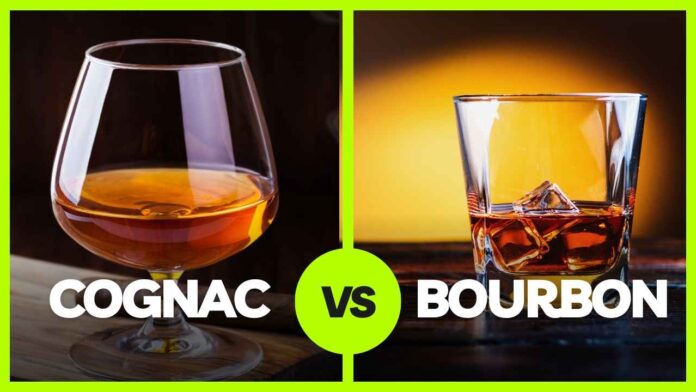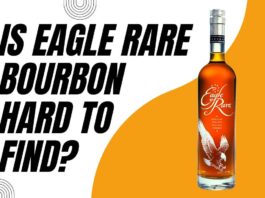This page may contain affiliate links. Please see our Disclaimer for more information. Always drink responsibly and adhere to your local legal drinking age.
There’s nothing quite like sipping on a smooth glass of brandy or whiskey at the end of the day. But what if you’re unsure whether to order a cognac or bourbon? After all, they both sound pretty sophisticated, right?
If you find yourself asking this question, you’ve come to the right place. In this article, we’ll help break down the key differences between cognac and bourbon so you can make an informed decision regarding your drink orders.
We’ll review everything from production to flavor profile, giving you all the information you need to become an expert in this classic alcohol debate: Cognac vs. Bourbon.
Cognac vs. Bourbon
Cognac and bourbon are two very different spirits. From flavor profiles to production processes, the differences between them are easy to spot. Here’s a quick overview of the key characteristics and qualities distinguishing cognac from bourbon.
- Taste Profile: Cognac tastes are typically sweet, smooth, and delicate. It has fruit notes and sometimes even floral flavors, such as vanilla and honey. Conversely, Bourbon has a more robust flavor—think spices, woody flavors like oak, intense caramel aroma, pecans, and sometimes even almonds.
- Production Process: Cognac is made from white grapes grown in the Cognac region of France that have been fermented and distilled twice. Bourbon is made from at least 51% corn and refined in the United States – usually Kentucky. Additionally, cognac must be aged for at least two years in French oak barrels before being sold commercially; bourbon does not have a minimum aging requirement except for being aged in new charred oak barrels for two years or more if it’s labeled as “straight bourbon whiskey.”
Understanding the critical distinctions between cognac and bourbon will help you decide which one is right for your palate when trying to decide between them!
What is Cognac?
Cognac is a brandy made from white grapes, primarily grown in France’s Charente and Charente-Maritime regions. It’s double-distilled in copper pot stills – double distillation being the defining difference between Cognac and other types of brandy. After that comes the aging process, which involves storing it in French oak barrels for at least two years, imparting a richer flavor.
A lot of Cognac’s popularity is attributed to its smoothness and complex aromas that can range from floral to nutty to citrusy. The longer it’s aged, the more expensive it will be – with some Cognac’s retailing for as much as $10,000 per bottle! In final form, Cognac is often served as an after-dinner drink or aperitif.
What is Bourbon?
You might have heard ‘bourbon’ before, but do you know exactly what it is? Bourbon whiskey is an American whiskey made from at least 51 percent corn. It’s then aged in new charred oak barrels for at least two years — and up to five or more.
Bourbon has a distinct taste; sweet, with vanilla, oak, and caramel aromas. And depending on the length it’s aged, you can also get hints of spice and tobacco.
Interestingly, bourbon was created by accident! In the late 1700s, river boats carried whiskey barrels along the Ohio River from Pennsylvania to New Orleans — but the long journey didn’t agree with all spirits. The barrels started developing a unique flavor known as ‘Kentucky bourbon.’
Today, bourbon is made all over America — and it must abide by specific regulations laid down by the US government to qualify — such as being aged in new charred white oak barrels. To be called a ‘straight bourbon,’ it must meet even higher standards – including a minimum aging of four years and no additives other than water or colorings.
How is Cognac Made?
You might already know that cognac and bourbon are distilled alcoholic drinks, but how they’re made is another story. Let’s look at how each of these spirits is produced.
Cognac Production
Cognac starts with the Ugni Blanc grape, which is explicitly grown in the Cognac region of France. The grapes are harvested, fermented, and double-distilled in copper stills until the alcohol content reaches around 72%. To age it, cognac is stored in casks made from limousin or tronçais oak for at least two years. As it ages, cognac develops its flavor and color—and can create even more character after 30 years or more.
Bourbon Production
On the other hand, bourbon starts life as a mixture of grains, including corn (at least 51%), barley, wheat, and rye. The grain mixture is mashed down, distilled, and aged in charred oak barrels for at least two years to develop its flavor profile.
As you can see, critical differences exist between how cognac and bourbon are made—which explains why they taste so different!
How is Bourbon Made?
So, let’s dive into how these two spirits are made. When it comes to bourbon, you should know that it is usually made from a combination of corn, wheat, and rye – sometimes using barley as well. The grains used depend on the type of bourbon being made and the particular recipes each distillery uses. The grains are then ground and mixed with water to create a mash.
The mash is then heated to convert starches in the grain to fermentable sugars before it is cooled and placed into fermentation tanks along with yeast, transforming the sugars into alcohol. After fermentation, the fermented liquid is then distilled to separate out any impurities and create a more concentrated form of alcohol.
Once distilled, bourbon is typically transferred into new American oak barrels for aging. These barrels give bourbon its characteristic flavor as compounds from the oak interact with compounds from the alcohol, resulting in a unique flavor profile. The spirit must be aged for at least two years before it can legally be called “bourbon.”
Bourbon can be bottled at any stage after distillation but must have an ABV (alcohol by volume) of at least 40% if labeled as “straight” bourbon whiskey. Anything lower than 40% ABV must be marked as “blended” whiskey or “flavored” whiskey if flavorings are added after distillation.
Key Differences
You might be wondering what sets cognac and bourbon apart. Well, there are a few key differences that make cognac and bourbon unique from one another:
Ingredients
The ingredients used to make cognac and bourbon are distinct from one another. Cognac is made from grapes, which give it its sweetness and subtle fruity notes, while bourbon is made primarily from corn, with other grains making up the rest of the recipe.
Distillation Processes
Another significant difference between these two spirits lies in their distillation processes. Cognac must go through a double distillation process before it’s aged in oak barrels for at least two years, whereas bourbon can be distilled once or twice but must be aged in new, American-charred oak barrels for at least four years.
Tasting Notes
When collecting tasting notes, cognac usually has subtler flavor profiles featuring hints of fruits like apricots and flowers — think of it more like a fine wine than a spirit. Conversely, bourbons will feature bolder flavors like caramel and sharp oak tannins — think of it more as a malt whiskey than as fine brandy or wine.
So there you have it! Cognac and bourbon may share some similarities – but they’re also different in many ways, thanks mainly to their respective ingredients, distillation processes, and tasting notes!
Taste and Flavor Profiles
When you taste Cognac and Bourbon side by side, you can instantly tell the difference between the two. Cognac has a light and fruity flavor profile, with notes of peach, apricot, rose petals, and even raisins. On the other hand, bourbon has a smokier, woodsy flavor with undertones of vanilla, oak, and spice. It’s like comparing a glass of red wine to a glass of white—the taste profiles are different.
Regarding aroma, Cognac offers a distinct bouquet of floral scents mixed in with some citrus notes. Meanwhile, a bourbon bouquet is usually spicier and earthier.
Depending on what kind of taste experience you’re after—something flavorful yet not overpowering or something that packs more punch—you can choose which one suits your palette the best.
The Origins
Bourbon and Cognac have deep origins in spirits, yet they are very different beverages. It is an American whiskey, while Cognac is a brandy from France.
Bourbon
Bourbon is a whiskey made chiefly from corn and aged in charred oak barrels. The first recorded mention of bourbon was in 1789 when Kentucky settler Elijah Craig started producing the drink. In 1964 the US Congress declared bourbon a “distinctive product of the United States,” making it one of the few liquors to receive such an endorsement.
Cognac
Cognac is a type of brandy made from grapes grown in the Cognac region of France. It has been produced in this area since at least 1653 and has become known worldwide for its distinctive flavor and aroma. To qualify as a cognac, it must adhere to strict production regulations regarding location, grape varieties, alcohol content, distillation process, and aging protocol.
Both bourbon and cognac have deep roots in their respective countries’ history and culture—and now you better understand why they are so different!
The Ingredients
Did you know that while cognac and bourbon are brown liquors, they are made from vastly different ingredients? Both have a minimum alcohol level of 40%, but the differences begin here.
Cognac Ingredients
Cognac is made from white grapes that grow in the Cognac region of France. The white wine is double-distilled in copper pot stills, then aged for at least two years in French oak barrels. This aging process produces the signature taste of cognac that many people love.
Bourbon Ingredients
Conversely, Bourbon is made from corn, fermented and distilled before entering oak barrels for aging. During this aging process, the bourbon absorbs a unique flavor from the charred oak casks used to store it. This gives bourbon its distinct taste when compared to cognac.
It all depends on what your preference is. You might prefer cognac over bourbon if your liquor is sweet and smooth with subtle spiciness and vanilla notes. On the other hand, if you like something with a nutty flavor profile and hints of caramel and toasted wood, you’re more likely to go for bourbon instead.
Aging and Barreling
Last but certainly not least, aging and barreling are critical components in the difference between cognac and bourbon.
When it comes to aging, both cognac and bourbon start in a new oak barrel. From there, however, the differences begin to emerge. Bourbon must be aged for at least two years before it can legally be labeled bourbon, whereas cognac must be aged for at least three years before it can be labeled as cognac. The aging times can vary from producer to producer, but these are the basic guidelines according to French and US regulations.
The types of barrels used also differ between cognac and bourbon. Cognac is aged in Limousin or Troncais oak barrels, while bourbon is aged in charred white oak barrels. This type of oak gives both types of whiskey their distinct flavors—the oaky taste common to both, but the charring makes for a smooth taste on the tongue for bourbon that you don’t get with cognac.
Overall, aging and barreling are what set cognac apart from bourbon, as well as other whiskey varieties. Knowing how long each whiskey is aged and what kind of oak barrels can help you hone your tasting skills to spot the differences between them more easily.
Pairing and Cocktails
When looking for a drink, you may opt for cognac or bourbon. And when it comes to pairing and cocktails, the two are pretty different.
Cognacs
Cognac pairs well with creamy desserts, like crème brûlée and cheesecake. You can also use it in cocktails like sidecars and French 75s. Some drinks are made explicitly with cognac, like the Vieux Carré and the Brandy Daisy.
Bourbon
Bourbon is usually considered a “sipping” whiskey, but it can also be used in classic cocktails like an Old Fashioned or Manhattan. If your preference is something on the sweeter side, try a Mint Julep or Whiskey Sour. Alternatively, you could even make an offshoot of these classics by swapping out the bourbon for cognac.
No matter what you choose to sip on or mix up, bourbon and cognac can make for unique experiences. But remember — both are solid drinks and should be enjoyed responsibly!
Pricing and Availability
One of the main differences between cognac and bourbon is the pricing and availability. While it’s true that you can find both of these spirits in most liquor stores, they differ when it comes to price. Cognacs are typically more expensive, with some reaching up to hundreds of dollars per bottle. Bourbons usually have a more reasonable price tag, starting around the mid-twenties range.
Plus, while bourbons can be found pretty easily in liquor stores anywhere, cognac might take a bit more digging. Many smaller liquor stores may not carry cognac due to its higher price tag, but you can always check online or in a specialty store for something higher-end.
The good news is that both bourbon and cognac are becoming increasingly popular worldwide, so if you want to get your hands on some, you should have no trouble. Happy hunting!
FAQ
You might have some other pressing questions about cognac and bourbon, so let’s dive into a few of the FAQs.
What is the difference between cognac and bourbon?
The main difference between cognac and bourbon is that cognac is a type of brandy made from grapes, while bourbon is a whiskey made from grain.
Is cognac only from France?
Yes! Cognac is an Appellation d’Origine Contrôlée (AOC) region in France, where it must be produced according to its specification by law.
Is bourbon only from the United States?
No, although the U.S. does makeup about 95% of all products for this spirit. But now you can find Bourbon produced in other places worldwide, like Japan or India.
What are some popular brands of cognac?
Many popular cognac brands are available today, including Hennessy VSOP Cognac, Remy Martin XO Excellence Cognac, Courvoisier Napoleon XO Cognac, and Martell Cordon Bleu Cognac.
What type of glass do you use for cognac?
The classic snifter glass with its broad base is usually used for mature or vintage cognacs as it encourages oxidation and allows you to enjoy the full taste experience. Though, tulip or balloon glasses may be preferable for younger or lighter spirits as they capture more aromas.
Conclusion
In conclusion, cognac and bourbon have several significant differences that set them apart.
Cognac is made from French grapes and is a type of brandy, while bourbon is made from corn and is a type of whiskey. It is aged in Limousin oak barrels, while bourbon is aged in charred oak barrels. Cognac is often more expensive than bourbon and is usually served as an aperitif or digestif rather than being used as an ingredient in cocktails.
Bourbon is often served in cocktails, such as the classic whiskey sour, and is also used in cooking.
So, the next time you decide which spirit to sip on, keep these critical differences in mind, and you’ll be on your way to becoming a cognac or bourbon connoisseur in no time.






